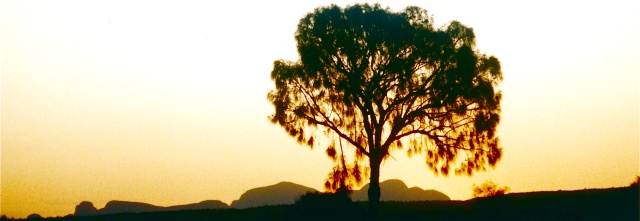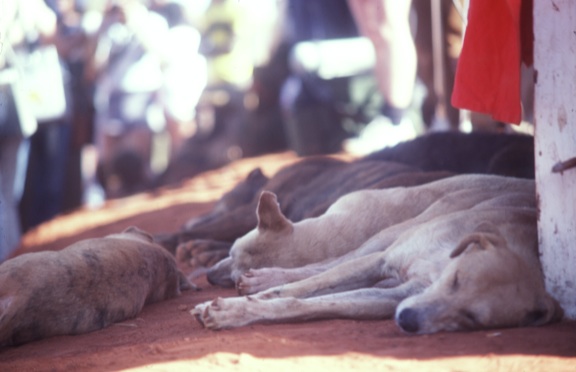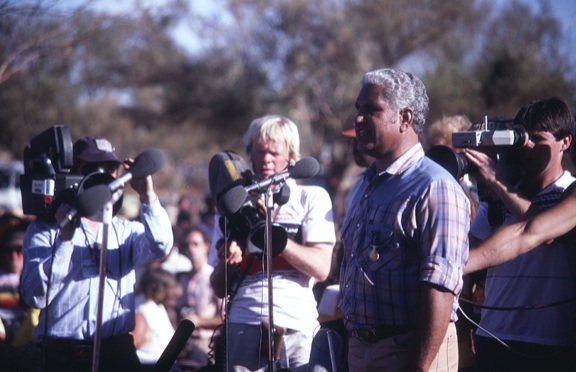A chance phone call from the regional mananger of ABC Alice Springs Radio 783, Stewart Brash, has stirred my memories of attending the handover of Uluru back to the traditional owners in 1985. Stewart traced me after finding on the internet some photographs I had taken at the event, thirty years ago. To commemorate the occasion, Stewart is collating some photographs for the station’s Facebook website, and a shot I took of a banner being dragged across the sky by a light plane on the day, proclaiming “Ayer’s Rock For All Australians” caught his eye.
The intrusion of that plane, at the moment of high excitement as the ceremony peaked, was intended to register the offence which some took at the hand-over, although some interpreted the message as a positive one.
A day before the ceremony I was having a beer in a pub in rural Mount Barker in the Adelaide Hills, when I saw an announcement on the television news about the handover. I immediately determined to get there, though both time and money were short. There were no direct commercial flights, busses or a train which could get me there on time it seemed, but somehow I stumbled across the possibility of scoring a ‘standby’ seat on a Fokker Friendship, departing Adelaide for Yulara Resort the next morning, a Saturday. With my backpack, a sleeping bag and a camera, and the payment of $70, I found myself flying low and slow over the mesmerising desert country on the way to Uluru.
Every trace of past rainfall and water-course was etched in patterns on the landscape, and the shadows of fluffy white clouds showed dark and sharp below against the vibrant coloured panorama. I wanted to shake my fellow passengers from their idle chatter and newspapers and to share the experience, but it seemed I was the only one captured by the magic.
Hours later, we tilted around Uluru and touched down on the tarmac of Connellan Airport. I stepped from the plane and into the warmest of sun, the brightest of colours, and an incredibly strong feeling of belonging.
I have posted on this blog previously my observations of the handback, so I won’t repeat them here, except to say that I got in a good position to take photographs, and was deeply moved by the occasion. After couple of days exploring the rock and Katajuta, I managed to get a ride into the Alice, board the Ghan, and trundle back to Adelaide. I caught a cab to Glen Osmond, stuck out a thumb, and was picked up by an old school mate, who dropped me at my home in the hills.
Five years later, after spending two years as the arts organiser at the Yuelamu Community in the Tanami desert, I was back at Yulara, selling artworks from the community at the Sheridan Hotel as they explored the potential for a new gallery in a closed down bar. I spent a lot of time at Yulara over the next few years, during which time I visited either the rock or Katajuta on a daily basis. About this time I got hold of a copy of Ayers Rock, by Charles Mountford, a seminal study of the creation myths of Uluru when knowledge of the stories was still very strong. This book confirmed what I had learnt during my time as an arts organiser; that every physical feature of the countryside was shaped by the adventures of the dreamtime ancestors, and that certain ‘skin’ groups had the ceremonial responsibilities for delegated sections of the land. Uluru, as revealed by Mountford, has a story for virtually every physical feature; rocks, caves, groups of trees, water stains and rock-holes, gashes in the surface, and the birds, plants and animals who frequent the region. One vivid tale tells of the evil spirit dingo, Kulpunya, sent by a tribe offended by a lapse in ceremonial protocol to slaughter the hare-wallaby people of Uluru. (Shades of the Chamberlains?)
I would explore a section of the rock on each visit, often sitting in a cave and contemplating the same view ancient eyes had taken in over millennia. It is sobering to realise that this whole great land mass was, a little more than 200 years ago, stitched together by song, dance, and ceremony.
Today the great monolith towers 350 metres above the surrounding desert oaks and sand dunes, while the Minga (ants) from the Yulara Resort to the north visit in their thousands, forming a line of tiny specks as they journey to the top. The Anangu watch from their third world settlement in the south-eastern shadow of Uluru, and observe the 21st century intrusion of their land. Their observation, from frowning brows, is analogeous to the view Uluru has. The stories are locked into the land, and the Minga an insignificent distraction; but the keepers of the ceremony are fewer in number, as the stories fade into infinity.
The culture is precious, and its preservation, paramount.




